2005 CHEVROLET CLASSIC ECU
[x] Cancel search: ECUPage 7 of 320
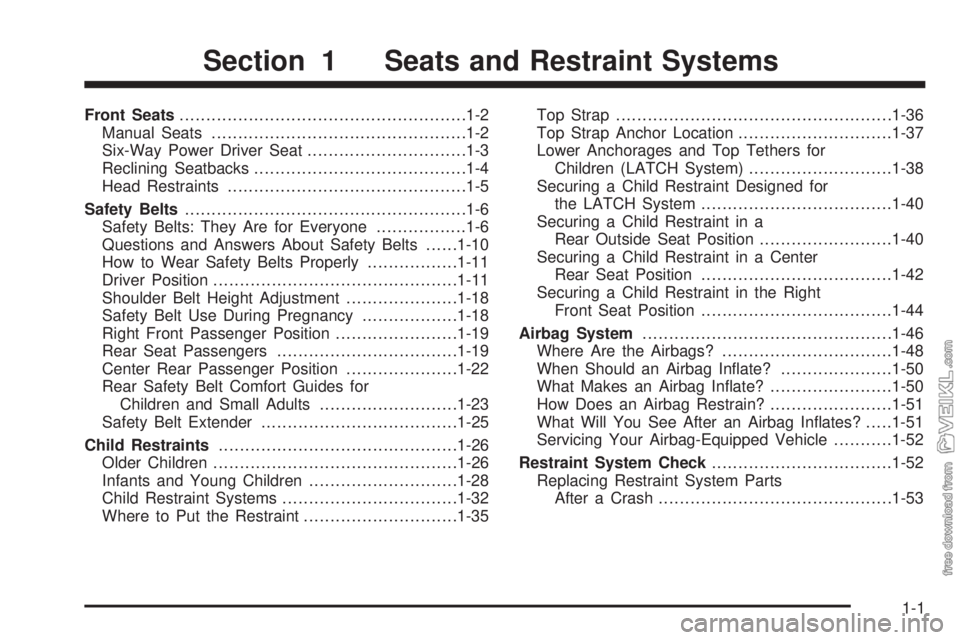
Front Seats......................................................1-2
Manual Seats................................................1-2
Six-Way Power Driver Seat..............................1-3
Reclining Seatbacks........................................1-4
Head Restraints.............................................1-5
Safety Belts.....................................................1-6
Safety Belts: They Are for Everyone.................1-6
Questions and Answers About Safety Belts......1-10
How to Wear Safety Belts Properly.................1-11
Driver Position..............................................1-11
Shoulder Belt Height Adjustment.....................1-18
Safety Belt Use During Pregnancy..................1-18
Right Front Passenger Position.......................1-19
Rear Seat Passengers..................................1-19
Center Rear Passenger Position.....................1-22
Rear Safety Belt Comfort Guides for
Children and Small Adults..........................1-23
Safety Belt Extender.....................................1-25
Child Restraints.............................................1-26
Older Children..............................................1-26
Infants and Young Children............................1-28
Child Restraint Systems.................................1-32
Where to Put the Restraint.............................1-35Top Strap....................................................1-36
Top Strap Anchor Location.............................1-37
Lower Anchorages and Top Tethers for
Children (LATCH System)...........................1-38
Securing a Child Restraint Designed for
the LATCH System....................................1-40
Securing a Child Restraint in a
Rear Outside Seat Position.........................1-40
Securing a Child Restraint in a Center
Rear Seat Position....................................1-42
Securing a Child Restraint in the Right
Front Seat Position....................................1-44
Airbag System...............................................1-46
Where Are the Airbags?................................1-48
When Should an Airbag Inflate?.....................1-50
What Makes an Airbag Inflate?.......................1-50
How Does an Airbag Restrain?.......................1-51
What Will You See After an Airbag Inflates?.....1-51
Servicing Your Airbag-Equipped Vehicle...........1-52
Restraint System Check..................................1-52
Replacing Restraint System Parts
After a Crash............................................1-53
Section 1 Seats and Restraint Systems
1-1
Page 18 of 320
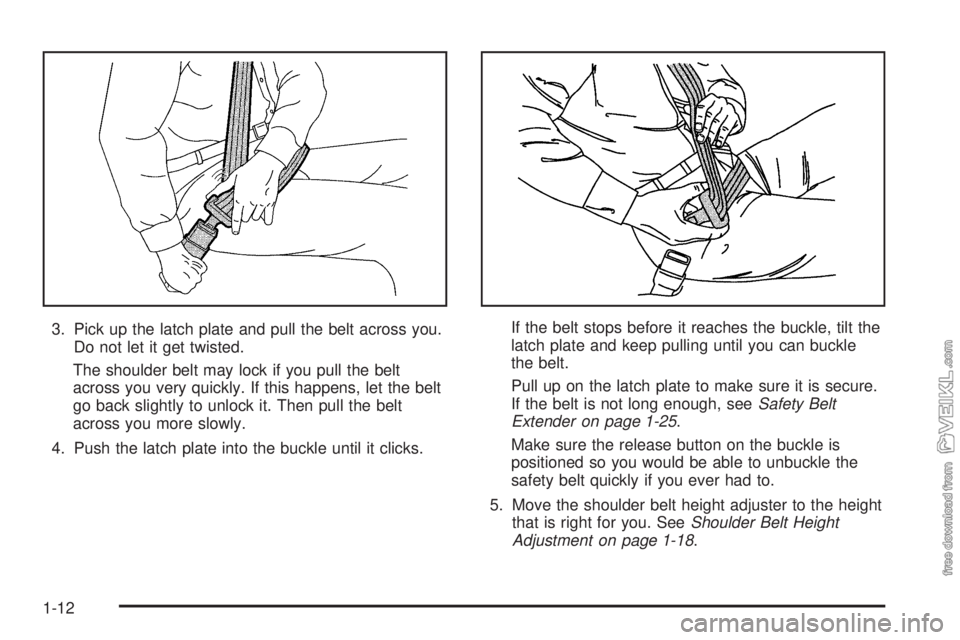
3. Pick up the latch plate and pull the belt across you.
Do not let it get twisted.
The shoulder belt may lock if you pull the belt
across you very quickly. If this happens, let the belt
go back slightly to unlock it. Then pull the belt
across you more slowly.
4. Push the latch plate into the buckle until it clicks.If the belt stops before it reaches the buckle, tilt the
latch plate and keep pulling until you can buckle
the belt.
Pull up on the latch plate to make sure it is secure.
If the belt is not long enough, seeSafety Belt
Extender on page 1-25.
Make sure the release button on the buckle is
positioned so you would be able to unbuckle the
safety belt quickly if you ever had to.
5. Move the shoulder belt height adjuster to the height
that is right for you. SeeShoulder Belt Height
Adjustment on page 1-18.
1-12
Page 26 of 320
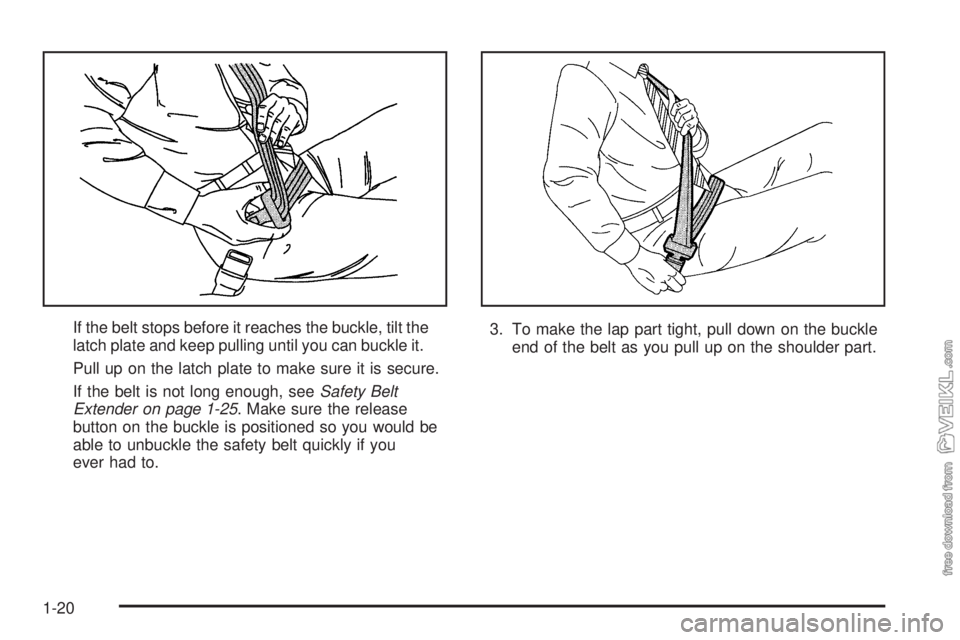
If the belt stops before it reaches the buckle, tilt the
latch plate and keep pulling until you can buckle it.
Pull up on the latch plate to make sure it is secure.
If the belt is not long enough, seeSafety Belt
Extender on page 1-25. Make sure the release
button on the buckle is positioned so you would be
able to unbuckle the safety belt quickly if you
ever had to.3. To make the lap part tight, pull down on the buckle
end of the belt as you pull up on the shoulder part.
1-20
Page 31 of 320
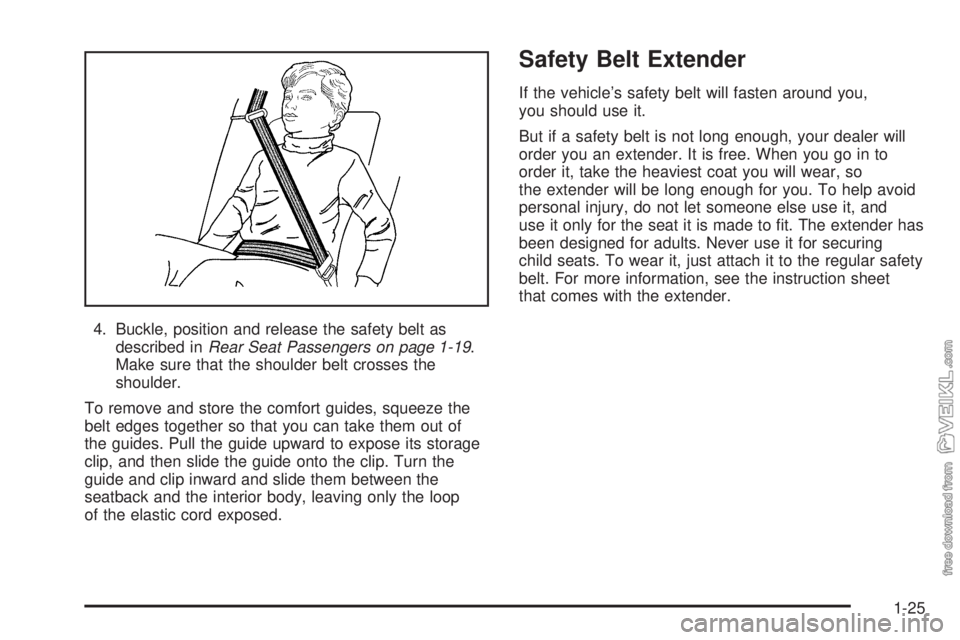
4. Buckle, position and release the safety belt as
described inRear Seat Passengers on page 1-19.
Make sure that the shoulder belt crosses the
shoulder.
To remove and store the comfort guides, squeeze the
belt edges together so that you can take them out of
the guides. Pull the guide upward to expose its storage
clip, and then slide the guide onto the clip. Turn the
guide and clip inward and slide them between the
seatback and the interior body, leaving only the loop
of the elastic cord exposed.
Safety Belt Extender
If the vehicle’s safety belt will fasten around you,
you should use it.
But if a safety belt is not long enough, your dealer will
order you an extender. It is free. When you go in to
order it, take the heaviest coat you will wear, so
the extender will be long enough for you. To help avoid
personal injury, do not let someone else use it, and
use it only for the seat it is made to fit. The extender has
been designed for adults. Never use it for securing
child seats. To wear it, just attach it to the regular safety
belt. For more information, see the instruction sheet
that comes with the extender.
1-25
Page 35 of 320
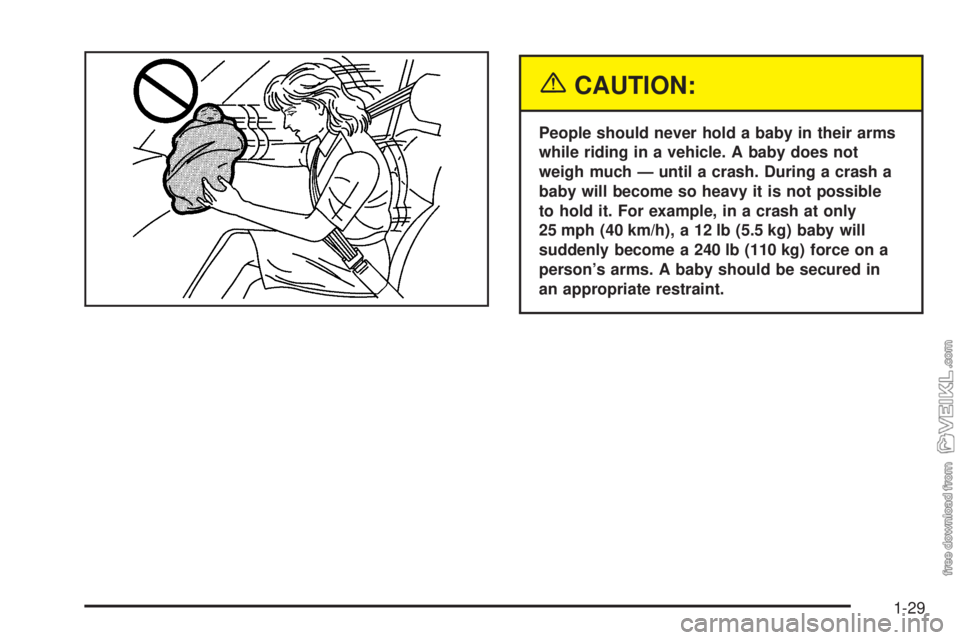
{CAUTION:
People should never hold a baby in their arms
while riding in a vehicle. A baby does not
weigh much — until a crash. During a crash a
baby will become so heavy it is not possible
to hold it. For example, in a crash at only
25 mph (40 km/h), a 12 lb (5.5 kg) baby will
suddenly become a 240 lb (110 kg) force on a
person’s arms. A baby should be secured in
an appropriate restraint.
1-29
Page 37 of 320
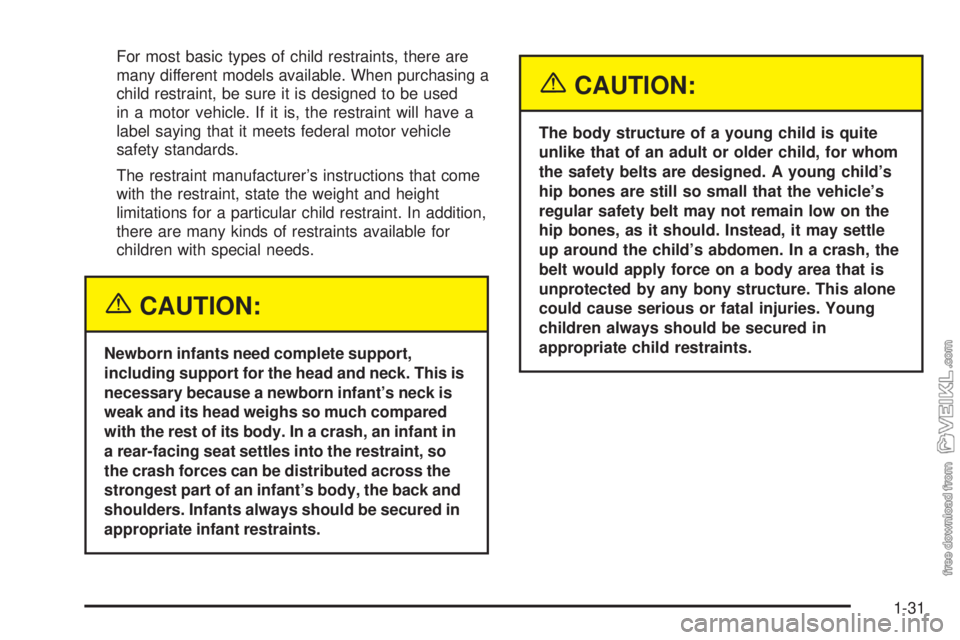
For most basic types of child restraints, there are
many different models available. When purchasing a
child restraint, be sure it is designed to be used
in a motor vehicle. If it is, the restraint will have a
label saying that it meets federal motor vehicle
safety standards.
The restraint manufacturer’s instructions that come
with the restraint, state the weight and height
limitations for a particular child restraint. In addition,
there are many kinds of restraints available for
children with special needs.
{CAUTION:
Newborn infants need complete support,
including support for the head and neck. This is
necessary because a newborn infant’s neck is
weak and its head weighs so much compared
with the rest of its body. In a crash, an infant in
a rear-facing seat settles into the restraint, so
the crash forces can be distributed across the
strongest part of an infant’s body, the back and
shoulders. Infants always should be secured in
appropriate infant restraints.
{CAUTION:
The body structure of a young child is quite
unlike that of an adult or older child, for whom
the safety belts are designed. A young child’s
hip bones are still so small that the vehicle’s
regular safety belt may not remain low on the
hip bones, as it should. Instead, it may settle
up around the child’s abdomen. In a crash, the
belt would apply force on a body area that is
unprotected by any bony structure. This alone
could cause serious or fatal injuries. Young
children always should be secured in
appropriate child restraints.
1-31
Page 40 of 320
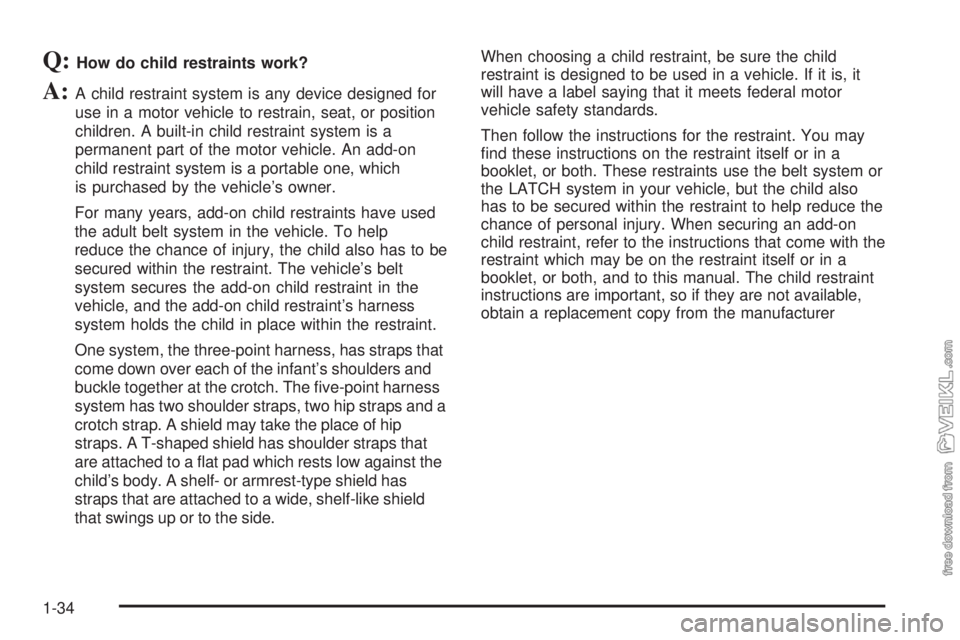
Q:How do child restraints work?
A:A child restraint system is any device designed for
use in a motor vehicle to restrain, seat, or position
children. A built-in child restraint system is a
permanent part of the motor vehicle. An add-on
child restraint system is a portable one, which
is purchased by the vehicle’s owner.
For many years, add-on child restraints have used
the adult belt system in the vehicle. To help
reduce the chance of injury, the child also has to be
secured within the restraint. The vehicle’s belt
system secures the add-on child restraint in the
vehicle, and the add-on child restraint’s harness
system holds the child in place within the restraint.
One system, the three-point harness, has straps that
come down over each of the infant’s shoulders and
buckle together at the crotch. The five-point harness
system has two shoulder straps, two hip straps and a
crotch strap. A shield may take the place of hip
straps. A T-shaped shield has shoulder straps that
are attached to a flat pad which rests low against the
child’s body. A shelf- or armrest-type shield has
straps that are attached to a wide, shelf-like shield
that swings up or to the side.When choosing a child restraint, be sure the child
restraint is designed to be used in a vehicle. If it is, it
will have a label saying that it meets federal motor
vehicle safety standards.
Then follow the instructions for the restraint. You may
find these instructions on the restraint itself or in a
booklet, or both. These restraints use the belt system or
the LATCH system in your vehicle, but the child also
has to be secured within the restraint to help reduce the
chance of personal injury. When securing an add-on
child restraint, refer to the instructions that come with the
restraint which may be on the restraint itself or in a
booklet, or both, and to this manual. The child restraint
instructions are important, so if they are not available,
obtain a replacement copy from the manufacturer
1-34
Page 41 of 320
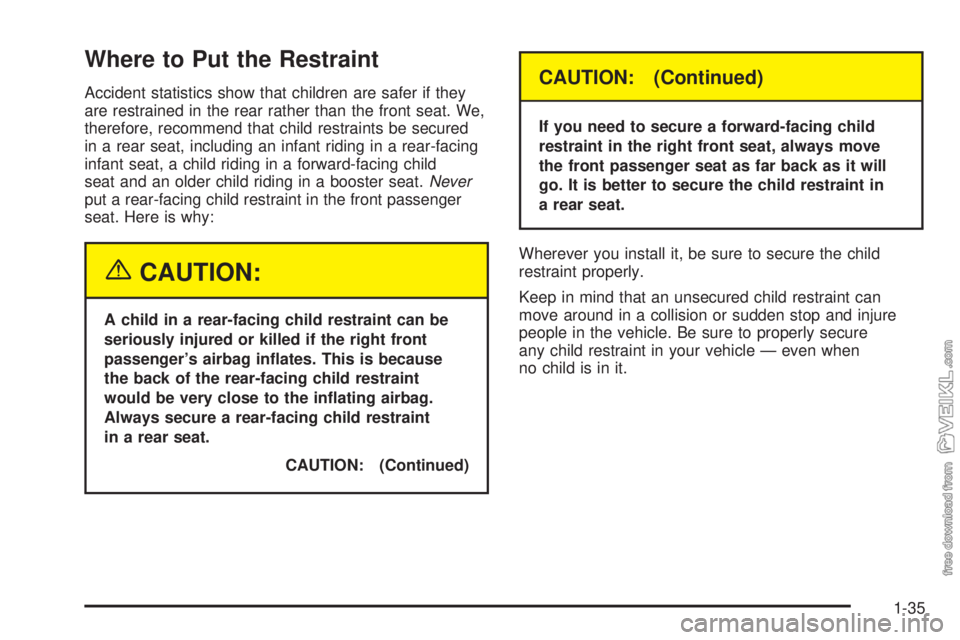
Where to Put the Restraint
Accident statistics show that children are safer if they
are restrained in the rear rather than the front seat. We,
therefore, recommend that child restraints be secured
in a rear seat, including an infant riding in a rear-facing
infant seat, a child riding in a forward-facing child
seat and an older child riding in a booster seat.Never
put a rear-facing child restraint in the front passenger
seat. Here is why:
{CAUTION:
A child in a rear-facing child restraint can be
seriously injured or killed if the right front
passenger’s airbag in�ates. This is because
the back of the rear-facing child restraint
would be very close to the in�ating airbag.
Always secure a rear-facing child restraint
in a rear seat.
CAUTION: (Continued)
CAUTION: (Continued)
If you need to secure a forward-facing child
restraint in the right front seat, always move
the front passenger seat as far back as it will
go. It is better to secure the child restraint in
a rear seat.
Wherever you install it, be sure to secure the child
restraint properly.
Keep in mind that an unsecured child restraint can
move around in a collision or sudden stop and injure
people in the vehicle. Be sure to properly secure
any child restraint in your vehicle — even when
no child is in it.
1-35